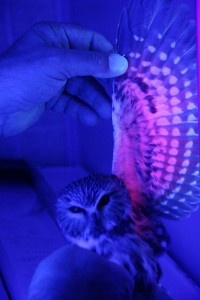Assigning age to migrant owls depends on flight feather molt, per Pyle (1997), and other criteria that vary by species. What follows is a discussion of reading molt sequences and the use of ultraviolet light help determine feather age – and thus assign an age class – in Northern Saw-whet Owls. Sub-pages present photographic examples of Northern Saw-whet Owl age classes.
Molt determination in white (visible) light
It is important for banders to use as bright and even a light source as possible for ageing migrant owls, as subtle differences in wear and fading may be masked by poor illumination. Use of ultraviolet light (below) is recommended, especially for distinguishing ASY (after-second year) adults. Banders should exmaine both wings, as asymmetrical molt is the rule more often than the exception, and we urge all banders to record full molt data for both wings on all owls older than hatching year.
Autumn HY (hatching year) saw-whet owls will exhibit evenly dark, glossy flight feathers with no molt limits. Feather edges will generally be smooth, with very fine, downy fringe intact.
Autumn SY (second year) saw-whet owls will generally have molted several to many outermost primaries (especially P10-5) and several innermost secondaries, with a continuous block of retained juvenile feathers in the middle of the wing. Molt limits are usually fairly obvious between the faded and worn retained feathers and new feathers.
Autumn ASY/AHY (after second year/after hatching year) saw-whet owls can exhibit a bewildering array of molt patterns, often including three visibly different generations of feathers. Such molt patterns are most obvious under ultraviolet light (below).
Use of ultraviolet (black) light
Owls are among 13 orders of birds that deposit pigments known as porphyrins in their feathers. Because porphyrins fluoresce under ultraviolet light, and degrade fairly quickly when exposed to sunlight, they provide a quick and highly effective means to assess flight feather age, a technique first pioneered in the early 1980s by barn owl researcher Bruce Colvin in Ohio. (For a full review of this technique, see Weidensaul, Colvin, Brinker and Huy 2011).
This technique is now widespread among saw-whet owl banders, most of whom use commercially available black UV light bulbs. Good results have been found with a 13–watt fluorescent blacklight (e.g. Feit Electric BPESL15T/BLB) with a screw-in base for use in lamps taking household incandescent bulbs; such lights typically come in both U-shape and a compact spiral. For field applications, new powerful UV LED flashlights have shown great promise. SAFETY NOTE: Use only long-wave (~360-400nm) UV sources. Short-wave UV (<254nm) can cause serious injury to the eyes of both owls and researchers without proper precautions.
Under UV light, the ventral surfaces of newly molted saw-whet owl flight feathers fluoresce an intense magenta color, brightest in the proximal third of the feathers, and faint or absent from the distal third. Underwing coverts fluoresce similarly. Most owls exhibit very little fluorescence on dorsal surfaces. Older feathers have fainter fluorescence, or may lack it altogether.
For those new to the use of wing molt patterns in assigning age classes to birds, it is best to read the Northern Saw-whet Owl sub-pages in order, from hatching year to second year to third year to after second year to after third year. This will help the beginner understand the sequence of feather changes that Northern Saw-whet Owls undergo during their first three years of life. Readers should also remember that, as with any living organism, there is substantial individual variation that may perturb the typical patterns described here.
Hatching-year (HY) saw-whet owls captured in fall migration show an even fluorescence across the underwing surfaces, most intense in the inner primaries and outer secondaries, and fading significantly across the innermost secondaries, which show little or no fluorescence.
Second-year (SY) owls captured in fall, which have replaced outermost primaries and innermost secondaries (most often P10-5 and S5-12), show a distinctive pattern of very bright fluorescence in these areas, separated by a continuous block of older retained juvenal feathers showing relatively little fluorescence limited to the base of the flight feathers.
Birds showing a mix of old and new feathers, but not in sequential blocks, are aged as after-hatching-year or after-second-year (AHY/ASY).

